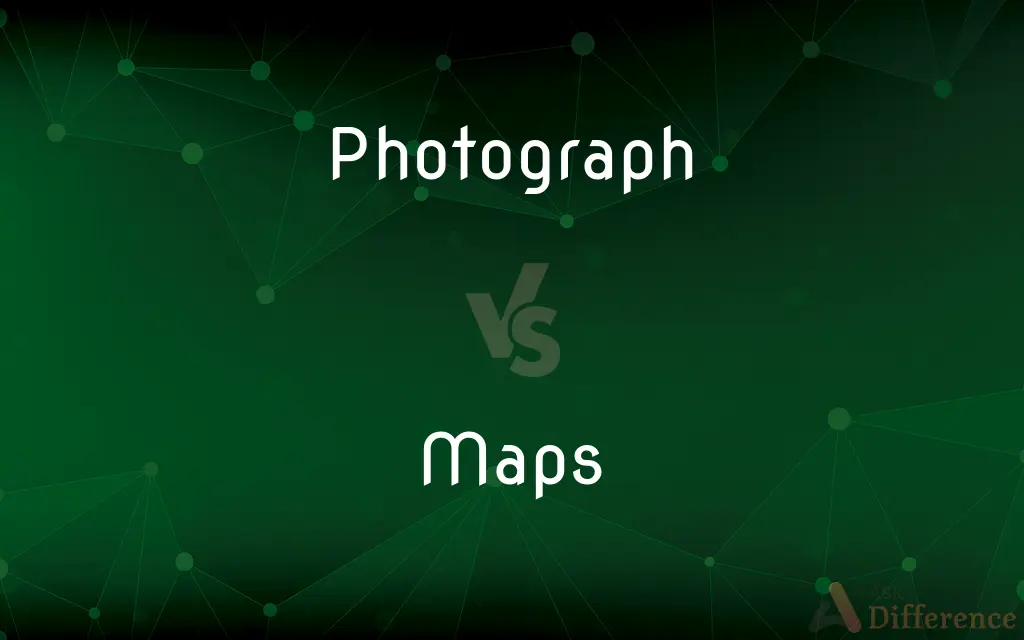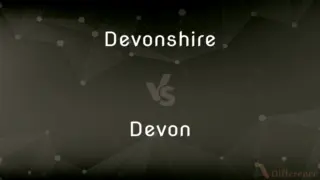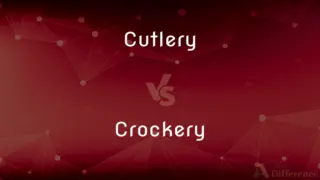Photograph vs. Maps — What's the Difference?
By Tayyaba Rehman & Maham Liaqat — Updated on March 26, 2024
Photographs capture real-time visual information and memories, displaying specific moments and details, while maps represent spatial relationships, guiding through geographical locations and layouts.

Difference Between Photograph and Maps
Table of Contents
ADVERTISEMENT
Key Differences
Photographs are a way to freeze a moment in time, preserving the visual details of a scene or subject as they appeared at a particular moment. They are often used for memories, documentation, and artistic expression. Whereas maps are abstract representations of spaces, designed to communicate geographical information, navigate environments, and illustrate spatial relationships between different elements such as roads, landmarks, and regions.
Photographs rely on light and cameras to capture images from the real world, showcasing colors, textures, and emotions. They can be both artistic and documentary, providing a direct visual connection to the past or present. On the other hand, maps are created using data about a location's geography and topology, often abstracting and simplifying complex real-world information into symbols, lines, and colors for easier interpretation and use.
While photographs can evoke emotions and capture the complexity of a moment, they are limited to what was in front of the camera lens at the time of capture. Maps, however, are tools for planning and analysis, focusing on spatial logic rather than emotional content, enabling users to understand and navigate spaces efficiently.
Photographs are primarily about detail, texture, and a specific point of view, often personal and subjective. They tell stories through visuals directly linked to reality. Maps, by contrast, prioritize accuracy, scale, and the relationship between different geographic features, providing an objective tool that helps decipher the environment from a broader perspective.
Maps and photographs serve different purposes but can complement each other. For example, a map can provide context to the location where a photograph was taken, while a photograph can offer a real-life view of a place depicted in a map, bridging the gap between abstract spatial representation and tangible reality.
ADVERTISEMENT
Comparison Chart
Primary Function
Captures visual moments in time
Represents spatial relationships
Medium
Light and camera
Data and symbols
Usage
Memory, documentation, art
Navigation, planning, analysis
Emphasis
Detail, texture, emotion
Accuracy, scale, spatial logic
Representation
Direct visual connection to reality
Abstract and simplified information
Compare with Definitions
Photograph
A visual record of a moment.
Her wedding album was filled with photographs capturing every detail of the day.
Maps
A depiction of geographic relationships.
The world map illustrates the continents and oceans.
Photograph
A captured image using a camera.
The photograph of the sunset over the lake was breathtaking.
Maps
A graphical representation of an area.
The map showed all the hiking trails in the national park.
Photograph
An art form using light.
The exhibition showcased photographs that played with light and shadow.
Maps
An educational resource.
The teacher used a map to explain the concept of continental drift.
Photograph
A tool for documentation.
Archaeologists use photographs to document their findings.
Maps
A planning aid.
Urban planners use maps to design city layouts.
Photograph
A means to share memories.
They exchanged photographs to remember their trip.
Maps
A tool for navigation.
Lost in the city, they consulted the map to find their way.
Photograph
A photograph (also known as a photo) is an image created by light falling on a photosensitive surface, usually photographic film or an electronic image sensor, such as a CCD or a CMOS chip. Most photographs are created using a smartphone/camera, which uses a lens to focus the scene's visible wavelengths of light into a reproduction of what the human eye would see.
Maps
A representation, usually on a plane surface, of a region of the earth, intended primarily to provide information about the relative location or nature of features within that region.
Photograph
A picture made using a camera, in which an image is focused on to light-sensitive material and then made visible and permanent by chemical treatment, or stored digitally
A photograph of her father
Maps
A similar representation of a region of the sky or of a celestial object
A map of the constellations of the southern hemisphere.
Photograph
Take a photograph of
She has photographed all of the major ballet companies worldwide
He was commissioned to photograph in the Crimea during the war
Maps
Something that suggests such a representation, as in clarity of representation
A map of the human genome.
Photograph
An image, especially a positive print, recorded by exposing a photosensitive surface to light, especially in a camera.
Maps
(Mathematics) The correspondence of elements in one set to elements in the same set or another set.
Photograph
To take a photograph of.
Maps
(Slang) The human face.
Photograph
To practice photography.
Maps
(Genetics) A genetic map.
Photograph
To be the subject for photographs
She photographs well.
Maps
To make a map of.
Photograph
A picture created by projecting an image onto a photosensitive surface such as a chemically treated plate or film, CCD receptor, etc.
Maps
To depict as if on a map
Grief was mapped on his face.
Photograph
To take a photograph (of).
Maps
To explore or make a survey of (a region) for the purpose of making a map.
Photograph
To fix permanently in the memory etc.
Maps
To plan or delineate, especially in detail; arrange
Mapping out her future.
Photograph
(intransitive) To appear in a photograph.
She photographs well. The camera loves her.
Maps
(Genetics) To locate (a gene or DNA sequence) in a specific region of a chromosome in relation to known genes or DNA sequences.
Photograph
A picture or likeness obtained by photography.
Maps
(Mathematics) To establish a mapping of (an element or a set).
Photograph
To take a picture or likeness of by means of photography; as, to photograph a view; to photograph a group.
He makes his pen drawing on white paper, and they are afterwards photographed on wood.
He is photographed on my mind.
Maps
Plural of map
Photograph
To practice photography; to take photographs.
Photograph
A picture of a person or scene in the form of a print or transparent slide; recorded by a camera on light-sensitive material
Photograph
Record on photographic film;
I photographed the scene of the accident
She snapped a picture of the President
Photograph
Undergo being photographed in a certain way;
Children photograph well
Common Curiosities
How do maps represent geography?
Maps abstract and simplify real-world geographical information into symbols and colors.
What is the difference between a photograph and a picture?
A photograph specifically refers to an image captured by a camera, whereas a picture can be any visual representation, including drawings and paintings.
What is the primary purpose of a photograph?
To capture and preserve visual details of a specific moment in time.
Can photographs be used for documentation?
Yes, photographs serve as a powerful tool for documentation, capturing precise details of events, places, and objects.
Why are maps important for navigation?
Maps provide spatial information and relationships between locations, making them essential for planning routes and navigating.
What are topographic maps?
Topographic maps show the terrain of an area, including hills, valleys, and rivers, using contour lines to indicate elevation.
Are all maps drawn to scale?
Most maps are drawn to scale, representing real-world distances in a reduced and proportional manner, though some may be stylized or thematic.
How do photographs convey emotion?
Through composition, lighting, and subject matter, photographs can evoke feelings and capture the emotional essence of a moment.
What role do photographs play in history?
Photographs are vital historical documents that provide visual evidence of past events, cultures, and people.
Can maps be interactive?
Yes, many modern maps, especially digital ones, are interactive, allowing users to zoom, pan, and access detailed information about specific locations.
Is photography considered an art form?
Yes, photography is widely recognized as an art form, offering creative expression through composition, lighting, and perspective.
What is the significance of scale in maps?
Scale determines how much a map is reduced from its real-world size, affecting the level of detail and area covered.
How do photographs and maps complement each other?
Photographs provide a real-life view of locations, while maps offer context and a broader understanding of geographical relationships.
How has mapmaking changed with technology?
Advances in technology have transformed mapmaking into a precise and data-driven process, with digital mapping and GIS enabling complex analyses and representations.
Can maps show more than geography?
Yes, maps can also depict various types of data, including demographic, climatic, and political information, through thematic mapping.
Share Your Discovery

Previous Comparison
Devonshire vs. Devon
Next Comparison
Cutlery vs. CrockeryAuthor Spotlight
Written by
Tayyaba RehmanTayyaba Rehman is a distinguished writer, currently serving as a primary contributor to askdifference.com. As a researcher in semantics and etymology, Tayyaba's passion for the complexity of languages and their distinctions has found a perfect home on the platform. Tayyaba delves into the intricacies of language, distinguishing between commonly confused words and phrases, thereby providing clarity for readers worldwide.
Co-written by
Maham Liaqat













































